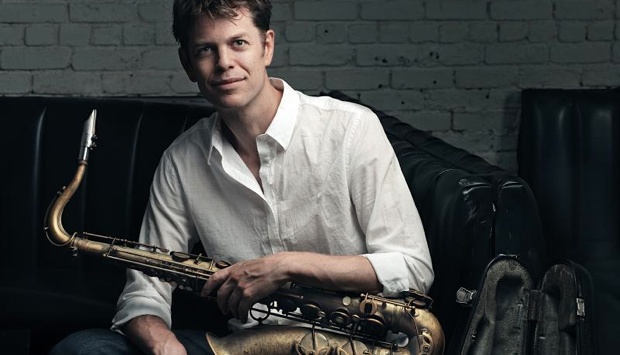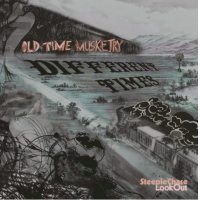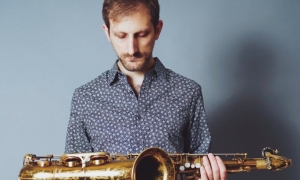Home » Jazz Articles » Interview » Donny McCaslin: Lightness and Gravity
Donny McCaslin: Lightness and Gravity

Already a recognized improviser of the first order, a string of strong solo albums drew attention to McCaslin's capabilities as a composer and leader. Recommended Tools (Greenleaf, 2008), featuring a punishing and revealing saxophone-trio format, featured in many critics' best-of-year lists.
McCaslin's Perpetual Motion (Greenleaf, 2011) featured electric instruments for the first time. But it could little prepare for the profoundly electric Casting For Gravity (Greenleaf, 2012). Here the saxophonist, a diligent student of saxophone colossi Sonny Rollins, Michael Brecker and John Coltrane, gives free rein to his passion for electronica music, remixes and dub reggae. The format pushes both the improviser and his audience well outside their comfort zones, but the result provides a fresh platform for McCaslin's restless creativity.
All About Jazz: Your new album is called Casting for Gravity. Tell us about the inspiration for this record.
Donny McCaslin: It's my tenth release as a leader, and I think the inspiration came out of the record I'd done prior to Casting for Gravity, which was called Perpetual Motion. And that was the first time that I'd done a record with electric bass and keyboards. [Keyboardist] Adam Benjamin played on that record; he used Fender Rhodes, but with a lot of effects.
 That was sort of my first foray into the electric realm. Then I started touring, touring that music, and I, frankly, was just really enjoying it, and got a group of guys together, the guys who played on Casting for Gravity, and I just felt like there was a real rapport there and it inspired me to write new music. And I was thinking about mining the electronica realm for inspiration. So I was listening to a lot of different electronica music, trying to not just make an electric kind of fusion record per se, but to push myself into more modern territory, get myself out of my comfort zone. And those were kind of the main things. I found it really fun to write for the band and then to participate in how the music developed while we were touring, which was a luxury to have, leading up to the recording. In a nutshell, that's what I would say about Casting for Gravity; just trying to do something different, push myself, again, out of my comfort zone and get into some new territory.
That was sort of my first foray into the electric realm. Then I started touring, touring that music, and I, frankly, was just really enjoying it, and got a group of guys together, the guys who played on Casting for Gravity, and I just felt like there was a real rapport there and it inspired me to write new music. And I was thinking about mining the electronica realm for inspiration. So I was listening to a lot of different electronica music, trying to not just make an electric kind of fusion record per se, but to push myself into more modern territory, get myself out of my comfort zone. And those were kind of the main things. I found it really fun to write for the band and then to participate in how the music developed while we were touring, which was a luxury to have, leading up to the recording. In a nutshell, that's what I would say about Casting for Gravity; just trying to do something different, push myself, again, out of my comfort zone and get into some new territory.AAJ: It's interesting that you mention your "comfort zone." In many ways, Perpetual Motion, while it did feature for the first time electric instruments, could fairly be called an electro-acoustic album. It really grew organically out of your previous releases. Casting for Gravity is really an electric album, it takes a further step.
DM: Exactly. I would totally agree with that and say that that was intentional.
AAJ: The quartet on this record includes bassist Tim Lefebvre and drummer Mark Guiliana, both of whom also appeared on Perpetual Motion. Keyboardist Jason Lindner, if I am not mistaken, is a newcomer to your discography. In fact, keyboards are somewhat rare in your discography. Tell us a little about the chemistry of this band, and the role that Jason plays.
DM: I've known Jason for many years and played with him in a variety of settings on the New York scene, played with his big band, and whatnot; His addition to the group, part of why there was so much chemistry there, is because he has a group with Mark Guiliana on drums, called Now vs. Now; a great trio, they have a great connection musically, and I feel like that instantly took the band to another level when he started playing with us. And his sonic sensibility is really developed. He's one of those rare guys who can navigate all these different sounds but do it in a really, really organic way. It feels like he's always of the moment with whatever he's playing. Jason's always willing to take chances, let things ride as far as they're going to go. So he really brings a really strong creative spirit to the band, and his sonic sensibility that he brings really is one of the key elements to the record, I think.
AAJ: These days, "going electric" doesn't have the stigma it had when Bob Dylan appeared with electric instruments at the Newport Folk Festival back in the '60s and was booed. But it's still a potentially destabilizing change for a musician, or for his or her audience. It takes you out of your comfort zone, as you mentioned. How are the rhythmic and harmonic elements of your playing changed in the midst of the "wall of sound" that you hear on this record?
DM: It's different. The challenge for me when I'm improvising over, as you described it, a "wall of sound," in a way I feel like I have to find a different language to draw from, to a certain extent. Of course, I'm still drawing from the language I've played for many years. But I feel like things that would maybe work in a different context, a different kind of record, don't fit this music. In other words, I'm not going to play over some of these songs with a lot of really, really long, flowing melodic lines, be-boppy kinds of things, because they just don't feel right to me stylistically.
So part of this for me is trying to learn, trying to figure out what I can play that feels true to the music, with the wall of sound happening. I think the rhythmic aspect of my language is still a big part of that. But it's different; it's a different kind of rhythmic basis. I'm thinking more about the rhythmic kind of stuff that I hear in electronica music, as opposed to different kinds of things that I've been heavily influenced by. I'm drawing a little bit more from that for my rhythmic sensibility. And also harmonically, too, some of these things are like static vamps; there's different ways to approach it, but sometimes I m trying to think more about textures and sounds on the saxophone and not so much about lines.
It's a little hard for me to put in to words, but I'm trying to find something, a way of playing, that really feels true to the music, and so that's what I'm searching for. Frankly I do that in whatever I'm doing, whether it's a trio setting or something like this, that's so different. And I'm just trying to find what feels honest to me as an improviser. Maybe I'm used to playing with a certain harmonic language and maybe it doesn't feel like that works. Well, what else can I find? Is it a repetitive rhythmic figure? Is it one note on the saxophone but with different colors and textures and fingering to give that note a different quality? And I guess that goes back to being pushed out of my comfort zone with this kind of music and the wall of sound, and it's a kind of challenge for me sometimes: what can I come up with that feels honest and feels strong?
AAJ: You've talked about the influence of electronica. On this record, as with many of you previous releases, there is a strong influence of music and musicians who would not usually be filed under "jazz." Who are some of these musicians, and how is their influence heard or felt on Casting for Gravity?
DM: Before I answer that specifically, I might just say that I think part of the reason that that's how I function is that I grew up playing in my father's band in Santa Cruz, California, and he played a variety [of different kinds of music]. He played Cal Tjader-esque Latin jazz, Great American Songbook standards, and R&B kind of tunes, "Feel Like Making Love," "Mustang Sally," stuff like that. I kind of grew up with that stuff all coexisting. And in Santa Cruz, there was also a salsa scene. I played in a salsa band as a teenager. I played some rock gigs of course, but also reggae was really popular in Santa Cruz. So I grew up in that kind of environment where all that stuff really coexisted equally. As well as playing primarily Duke Ellington music with my high school big band, which was an incredible experience. So all that kind of stuff, I've always kind of felt like I just drew from what was moving me.
Specifically in terms of Casting for Gravity, there's an electronica artist called Aphex Twin—I think his real name is Richard James, he's from the UK—his music, especially a record of his called Drukqs (Warner Bros., 2005). There's maybe half a dozen tracks on that record that I just listened to over and over: just absorbing his rhythmic language, checking out the melodic thing and what was happening with that. So that was a big influence, the primary influence, if I were to say.
Also Boards of Canada; I obviously covered one of their songs on the record ["Alpha and Omega"]. The record that it was on, called Geogaddi (Warp, 2002), I listened to a lot. Squarepusher I've listened to for many years—big influence. There's a couple people I'm forgetting. OK, there's a group of DJs in London called Fabric, I think, and there's a series of records called FabricLive (Fabric, 2001-present); they do some remixes, basically dub stuff, and I listened to that record a lot in preparing for this.
Also, the Roots; just checking out ?uestlove and the different drum sounds on a couple of their records was really informative for me. And then some of the earlier influences that I still go back to are Tower of Power and the Headhunters. In terms of electronica, it's those other artists. Plus, there's some electronica, pop electronica, folks like Imogen Heap who I like, you know, it's more conventional. But in truth, for this record, it's the DJ guys. Oh, yeah—Venetian Snares is the other guy; I listen to him a lot.
AAJ: As a follow-up, what and who are some of the jazz influences that prevail on this record? I ask you this because you have one of the most well-developed and individual voices in contemporary jazz, both as a soloist and as a composer—indeed, as a leader—and it's not at all clear whose shoulders you're standing on, if you know what I mean.
DM: That's hard for me to answer. There've been certain periods in my life when I've been really heavily influenced by players, which I could name. And then over the years, there've been different periods [where] I've been into different people. I don't often sit back and listen to myself and think about, "Whose influence do I hear?" I just try to put it together in a compelling way. But I think when I was quite young, my main influences were John Coltrane and Michael Brecker, and in my twenties I got really, really heavily into Sonny Rollins. And Wayne Shorter.
So, for me, in terms of the rhythmic thing that we talked about a little bit, I would say that's primarily coming from Sonny Rollins. And then various extensions of other people that, to me, come from Sonny Rollins. And then, sound-wise; I think especially with this kind of music, I'm sure the Michael Brecker influence is there, but also Jan Garbarek. I mean, one of my favorite records as a teenager was [pianist] Keith Jarrett's record Belonging (ECM, 1974), which Garbarek is on and his sound is incredible. So I think that's something that's always been compelling is that wonderful sound of Jan Garbarek.
So, that would be my Readers Digest answer, sort of looking back over my life. I think those were the main things, but there's a lot of other stuff, too. And you know the rhythmic language initially comes from Sonny Rollins, but then I spent a lot of time studying Afro-Cuban music and Afro-Peruvian music and Brazilian music and African music, just to inform my rhythmic vocabulary, coming from the drums as opposed to coming from a melody player. To try to get deeper into it.

AAJ: You're touring in Europe right now, and then across the US and Canada in the coming months. Is the touring group the same that appears on the record?
DM: It's mostly the same quartet, but sometimes it's different, depending on folks' availability. From [February], it's the group from the record and then at a certain point, Nate Smith takes over the drum chair for that last bit of February, and early March. So sometimes it's different people. But for the most part, it's the guys from the record.
AAJ: You said that the music on this record was really born out of performance. Casting for Gravity is a beautifully produced recording, but it doesn't necessarily sound like a concert date. What challenges does the music present when it comes to live performance?
DM: Well, sometimes when you're traveling, the equipment isn't your first choice of equipment, so sometimes sonically it can be a little challenging. But I do think that the intensity that you hear on the record is how we play live, and I think that translates. So sometimes hearing it live, yeah, there are not as many sonic elements, because on the recording we had the luxury of having three different keyboard tracks happening at once, all doing different things, and of course live, you don't have that luxury. But it's still sounds pretty full live and the intensity that we play with on the record comes across live, so to me that makes up a little bit for the lack of hands [laughs].
AAJ: What projects can we be looking for over the next six months to a year?
DM: I want to do another record with this group. So I'm actually going to the airport today to go to Europe and going to start working on new music as we're on the road. And I've written some music for a sax quartet so I'm going to do a concert in September at the Rubin Museum [of Art, in New York City]. So that's something I'm thinking about doing potentially more, with sax quartet. And also I'm contemplating doing some very pared-down acoustic ballad project or something like that. But really for me the focus is this band right now, because I'm having so much fun doing it.
Selected Discography
Donny McCaslin, Casting For Gravity (Greenleaf, 2012)
Donny McCaslin, Perpetual Motion (Greenleaf, 2011)
Donny McCaslin, Declaration (Sunnyside, 2009)
Donny McCaslin, Recommended Tools (Greenleaf, 2008)
Donny McCaslin, In Pursuit (Sunnyside, 2007)
Maria Schneider Orchestra, Sky Blue (ArtistShare, 2007)
Donny McCaslin, Soar (Sunnyside, 2006)
Dave Douglas, Meaning and Mystery (Greenleaf, 2006)
Matthias Lupri Group, Metalix (Summit, 2006)
Donny McCaslin, Give & Go (Criss Cross, 2006)
Gene Ess, Sandbox and Sanctum (SIMP, 2005)
Greg August, Late August (Self Published, 2005)
Maria Schneider Orchestra, Concert in the Garden (ArtistShare, 2004)
Donny McCaslin, The Way Through (Arabesque, 2003)
Danilo Pérez, ...Till Then (Verve, 2003)
Alex Sipiagin, Mirrors (Criss Cross, 2003)
Hans Glawischnig, Common Ground (Fresh Sound New Talent, 2003)
Deanna Witkowski, Wide Open Window (Khaeon, 2003)
Bruno Råberg, Chrysalis (Orbis, 2002)
Mary Ann McSweeney, Thoughts of You (Sparky 1 Productions, 2001)
Donny McCaslin, Seen From Above (Arabesque, 2000)
Reuben Wilson, Organ Donor (Jazzateria, 1998)
Lan Xang, Lan Xang (Mythology, 1998)
Donny McCaslin, Exile and Discovery (Naxos, 1998)
Steps Ahead, Vibe (NYC, 1996)
Photo Credit
Courtesy of Donny McCaslin
Tags
Donny McCaslin
Interview
Jeff Dayton-Johnson
DL Media
United States
New York
New York City
Maria Schneider
Dave Douglas
Sonny Rollins
Michael Brecker
John Coltrane
Adam Benjamin
Tim Lefebvre
Mark Guiliana
Jason Lindner
Bob Dylan
Cal Tjader
duke ellington
Aphex Twin
Wayne Shorter
Jan Garbarek
Keith Jarrett
Nate Smith
PREVIOUS / NEXT
Support All About Jazz
 All About Jazz has been a pillar of jazz since 1995, championing it as an art form and, more importantly, supporting the musicians who make it. Our enduring commitment has made "AAJ" one of the most culturally important websites of its kind, read by hundreds of thousands of fans, musicians and industry figures every month.
All About Jazz has been a pillar of jazz since 1995, championing it as an art form and, more importantly, supporting the musicians who make it. Our enduring commitment has made "AAJ" one of the most culturally important websites of its kind, read by hundreds of thousands of fans, musicians and industry figures every month.





















